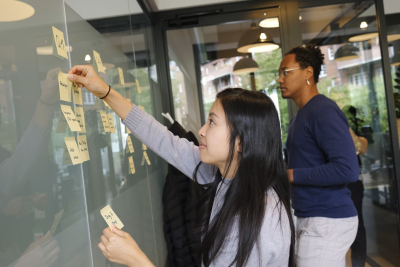

By Kelly O'Connell | Thu, May 29, 25
This post was co-authored with Chase Macpherson, Community Solutions Manager at NEEP.
Transportation plays a pivotal role in creating energy-efficient, healthy, and resilient communities. Since 2023, NEEP has led a project with communities in New England to advance mobility, greenhouse gas emissions reductions, and community-level capacity building through community-driven transportation plans. In the first phase of the project, NEEP and its partners in Connecticut, New Hampshire, and Vermont engaged community members to identify their main transportation needs. Now, in the second phase, the team is pivoting to developing implementation plans to build local capacity for improving mobility and increasing the adoption of alternative fuel vehicles (AFVs).
The four target communities are the Champlain Valley in Vermont, the Upper Valley in Vermont and New Hampshire, Bridgeport, CT, and Winsted, CT. The project partners consist of technical experts and community-based organizations in each of the four communities, with NEEP serving as a regional facilitator. Our last blog on this topic, "Community Partnerships for Transportation Planning," outlined the importance of partnerships through some initial findings from early in the project.
This U.S. DOE-funded project consists of three phases – (1) building relationships and conducting transportation needs assessments with each community, (2) identifying high priority action items to address transportation needs and creating detailed plans to guide the communities in accomplishing priority actions, and (3) providing technical support and workforce development opportunities related to AFVs.
Community Engagement Approaches are Key to Success
Over the last year, our partners carried out a series of outreach and engagement events in their communities to assess their transportation needs. Central to each partner’s approach was a survey to gather data on the status of transportation options and patterns and to provide insight into public opinion on AFVs. Altogether, 438 survey responses were collected through tabling at partners’ engagement events.
Our community-based partners also met their residents in local venues to hear their experiences, share initial findings, and offer resources and hands-on activities. The Upper Valley and Vermont Clean Communities Coalition (VTCCC) hosted listening sessions paired with community presentations and a ride-and-drive event. Live Green CT hosted a two-part forum series to present the barriers they identified through the survey and to share potential solutions in the Connecticut towns of Bridgeport and Winsted. Most participants opted to receive compensation for their time and input. To learn more about how the team compensated participants, see the Compensation Plan for Community-Based Organizations and Individual Community Members.
Transportation Audits Reveal Common Barriers, and a Few Surprises
Using the results from this comprehensive engagement, the partners identified primary barriers to transportation planning and access in their areas. In their transportation needs assessment reports, each partner compiled engagement methods, results, and barriers that surfaced as most relevant for residents. Among the target communities, the barriers cited most often were up front and maintenance costs, lack of AFV fueling infrastructure, and barriers surrounding identity and values alignment.
For many low-income community members, including those in Bridgeport and the Champlain Valley, affordability is the principal barrier, with many relying on public transit as their primary mode of transportation. Across all four target communities, misconceptions about the upfront costs to purchase an AFV, and a lack of knowledge of ongoing fuel and maintenance expenses were reported as barriers. In rural communities like Winsted and the Upper Valley, many people rely heavily on personal vehicles. For these residents, limited or no access to AFV charging and fueling infrastructure can trigger range anxiety, which limits AFV adoption. Uniquely in Bridgeport, the team noted that some people identify strongly with owning and driving a certain brand or type of car, and this can preclude consideration of AFVs particularly for this community.
In assessing these barriers and others that arose, the team identified potential solutions with their community stakeholders. Labeled as “high priority action items,” these next steps will form the basis of the final transportation plans. The reports will be published with our other resources soon and include further details on the barriers and solutions in each of the communities.
Turning Findings into an Action Plan
The recommended action items include car or ride share programs that allow people to use or get rides in shared AFVs, community-driven charging infrastructure planning, long-term education and outreach campaigns including test drive events, support for transit authorities with fleet electrification, and workforce training on battery safety. The teams are also thinking about how they can support electric bikes and scooters as an “on ramp” to other battery-powered vehicles and increased transportation options.
Teams are currently circulating the reports to stakeholders in their regions, including those who would be involved in implementing suggested measures. It is critical that the communities feel ownership over the plans, ensure that they address local needs, and are invested in implementing the action items. The teams can tailor technical assistance and planning to the high-priority action items during phases two and three.
Reaching a Regional Audience
NEEP works across the New England and Mid-Atlantic regions, and we want to share lessons learned through this project with a larger audience across the Northeast. To disseminate learnings from the transportation audits and future project activities, NEEP is convening a “Community of Practice” with the target communities and a broader regional audience. We will share transportation planning resources, notices of webinars, project updates, and replicable framework models via an Online Transportation Planning Resource Center. One early event was a webinar on car sharing programs, highlighting CarShare Vermont and Commute with Enterprise. NEEP has also started offering weekly office hours on Fridays at 2:00 pm, to connect with members of the Community of Practice, answer questions about the project, and provide technical assistance or resources to support other regional transportation related projects.
If you would like to join our Community of Practice, please sign up for email updates. For more information on the project or further questions about joining the Community of Practice, please visit our Clean Transportation Planning Resource Center.



